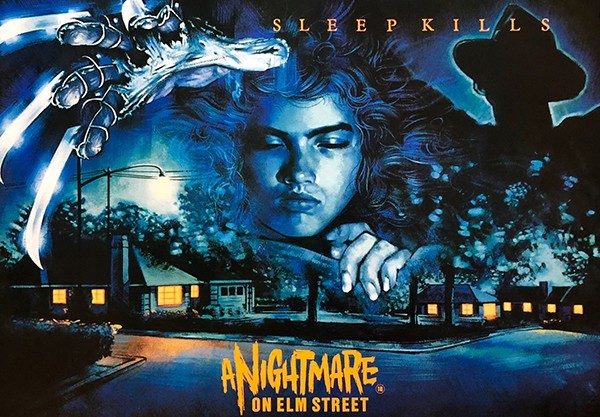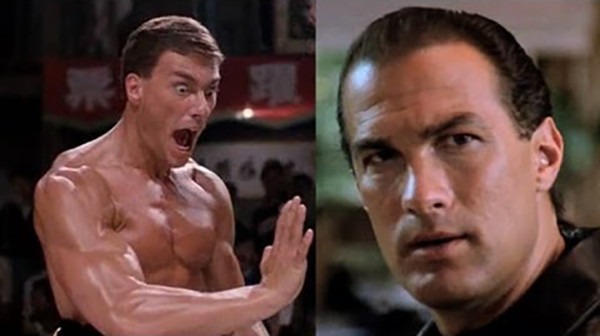Tom Jolliffe on what makes the A Nightmare On Elm Street series the best horror franchise…

Sequels had a significant boom throughout the 80’s. From then on, what had been an irregular practice prior, was increasingly common. Nowadays of course, everything is about franchise potential.
Two genres in particular were most prolific as far as franchising. Action and horror. Those genres just lend themselves to sequel potential, with continuing adventures often in the offing. We’ve seen a whole host of horror films become franchises. Some got as far as trilogy, like Sam Raimi’s Evil Dead threesome. Had we seen the oft rumoured follow up to Army of Darkness, then Raimi’s Ash canon might have pushed close to being the subject of this piece. There have been a lot though. The Halloween films, Friday the 13th, Hellraiser, Child’s Play, Scream, Saw, Final Destination. Loads. Something about horror, and the indestructible or interchangeable nature of the antagonists leaves the genre ripe for sequels.
Still, whilst there’s some mixed offerings amongst all those franchises, they all fall short in achieving the quality and interest of one which was started by Wes Craven. A Nightmare On Elm Street, which launched both New Line Cinema and Johnny Depp, had one thing that its most popular rivals (Friday and Halloween) didn’t… a villain that existed in dreams. One who haunted the subconscious and could inflict actual physical pain and death on his victims. The haven of ones bed, of being able to sleep in peace was taken away by a horror concept so brilliant, they could stretch over 6 canon, and one extension of the lore. Dreams can be surreal. Logic doesn’t need to exist to an extent in the dream world. What this certainly allowed, apart from anything else, was the ability to push the boundaries visually, in a way that a lot of the Halloween or Friday sequels couldn’t do (and sometimes when they went outside the box, it didn’t quite work). Now you could look and argue that if you’re talking one to one battles, Halloween is arguably the most iconic and supremely crafted slasher, but it really is a tight toss up between that and Craven’s original.
One thing I love about the Nightmare franchise is it had an ability to switch up the rulebook and the tone between films. Each sequel, for one reason or another feels like its own individual entity. Each has slowly garnered its own individual cult following. Lets look again at the first one though. It’s the most stripped back of the lot, but still loaded with unsettling and iconic imagery. Bear in mind too of course, it was a low budget film with a director who was unfancied. If you’re talking iconic horror of the 80’s, the two films with the most simplistically brilliant concepts were Craven’s original and James Cameron’s The Terminator. The latter, this relentless, nigh-on unstoppable machine from the future, in a time ill equipped to stop it. Ironically, Cameron got part of his inspiration for the T-800 from a nightmare. Craven too, became fascinated by stories of people dying in their sleep having suffered recurring nightmares. The first Nightmare film is a horror masterpiece. Craven, like Carpenter, never got enough credit as a craftsman. Moments in the film whether it’s Amanda Wyss being thrown up walls and ceilings, Johnny Depp being sucked into his bed and emerging only as an eruption of blood, a knived glove emerging from beneath the water as Heather Lagenkamp sleeps in the bath or Freddy Krueger emerging out from the wall behind her bed as she sleeps, are absolute genius. What other horror is so loaded with so many ingenious and spine-tingling moments?
The sequels never had that impact, but in their own respective ways all had their own individual qualities. A Nightmare On Elm Street 2: Freddy’s Revenge has taken on a life of its own in years since, as piece of LGBT cinema. People watch the film ironically, or they watch it with interest. The notion too that becomes a film about suppressing sexuality is quite interesting, but looking with a purely horror gaze, the rule flip sees Krueger possessing and psychologically tormenting Jessie (Mark Patton). The film had a lot of craft to it and after initially underwhelming audiences, the appreciation has come in the last 15 or so years. Jack Sholder certainly had a strong sense of visual style as a director, and also managed to instil a sense of persistent, uncomfortable, heat to the film. It’s 90 minutes of relentless sweat, set during a heat wave, and accentuating those Krueger associations with heat, boiler rooms and fire. The film makes you feel clammy. There’s also some exceptional effects here, and I really dug the slightly contentious alterations to the ‘look’ of Krueger in this one.

Krueger as a character took another turn in A Nightmare on Elm Street 3: Dream Warriors. Two hits down the line, although the studio probably expected to secure more numbers on the previous, saw Krueger become more noticeably comical. The film wasn’t as overtly scary and came at a period where the music video fascination was rife, so an accompanying soundtrack was particularly prominent (with 80’s rockers Dokken producing the title track). Dream Warriors managed to have an interesting concept though, and also brought back Heather Lagenkamp (her absence another point of contention in the second film). This is the point of the franchise where the overriding goal is fun over scares. Still, it works effectively in building up tension and manages to get a group of likeable characters into some memorable situations. The biggest factor as to why it works though is the relish that Robert Englund takes in being more prominent. You begin to almost root for Krueger. There had always been a dark and macabre humour to him, but it was far more overt now.
If there was a leaning for some music video style visuals in the third, then the fourth film, directed by Renny Harlin took a dive in the MTV deep end. The visual excess in this film would make peak era Dario Argento proud, and there’s a definite appreciation of 70’s Italian horror films along with the music video style. This film sort of repeated certain elements of the third film, but again, did so with some affable characters. The cheese levels elevate and the comedic stylings of Freddy were as overt as they’d ever been. I mean all they stopped short of was having him spotlit against a brick wall backdrop with a stand mic. Still, like Dream Warriors (without quite the ingenuity of set pieces), The Dream Master is a lot of fun and loaded with great visuals. I think what is most interesting about 3 and 4 perhaps, is that for the first time in the franchise there feels like a direct continuation. If the move from first to second felt very different, and two to three likewise, then three and four feel like a two parter. Still, the film itself has its own unique visual style, and again, the standard of visual artists helming these films was on a great run. Though it must be said another distinct advantage the third had over four was the cast, with Patricia Arquette a major strength in Dream Warriors (she was replaced in the fourth by Tuesday Knight who didn’t quite have the magnetism).
The run of visual directors continued in the fifth film, Dream Child. This had a continuity from the fourth film, continuing the story of Alice (Lisa Wilcox). There was a little more of leaning into the back story behind Krueger which offers some interest here, as well as some enjoyably surreal set pieces, but the film tends to fall flat in places. It’s a little forgettable, and whilst the visuals from Stephen Hopkins feel like a concerted effort to pull the reigns on the visual excess of the last one, it feels a little flat in comparison, though it is still a good looking film. This probably became the point that the films were resting too heavily on Englund’s charisma and running out of engaging new ideas. Those pieces of interest didn’t amount to enough to hold the entire film. Still…it bettered what was to come in an utterly dreadful sixth film which took Freddy into 3D… or at least would have done if the 3D worked. The less said about the story and the film itself though, the better. At that point, in 1991, Freddy’s appeal was growing stale. He needed a re-invention.
This came in A New Nightmare. Craven returned and went meta. Whilst taking a wry look at a franchise he kicked off, he also skewed the line between the characters, and the actors who played them, with Englund and Lagenkamp (and indeed Craven) all appearing as themselves. A demon begins tormenting Lagenkamp and manifests as Krueger, bringing a fictional character effectively to life. It’s a really underrated film. I think it was before its time, and people were still sour on a couple of underwhelming Nightmare canon films when it first came out. Craven would hit a much more successful not with Scream, but in retrospect, A New Nightmare is the more interesting film. The beauty of the film is how it could renew and evolve Krueger and make him a character of fear again, in a film that felt new.

No other horror franchise has managed to transition and re-invent as successfully as The Nightmare franchise. Craven bookends the whole run perfectly too with the iconic original and a story that offered an interesting and creative comeback. In between there was a wealth of creativity, great visuals, brilliant soundtracks, some excellent cast members and plenty of interesting ideas. Like all franchises there are duffers, but even the 6th film isn’t quite as bad as some rival franchise sequels.
What is your favourite horror franchise? What’s your favourite Nightmare on Elm Street film? Let us know your thoughts in the comments below or on twitter @flickeringmyth..
Tom Jolliffe is an award winning screenwriter and passionate cinephile. He has a number of films out on DVD/VOD around the world and several releases due in 2020, including The Witches Of Amityville Academy (starring Emmy winner, Kira Reed Lorsch) and Tooth Fairy: The Root of Evil. Find more info at the best personal site you’ll ever see here.
















